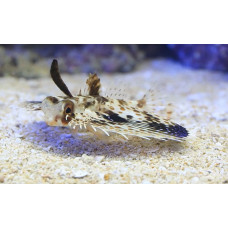Latin name
Dactyloptena gilberti
Other name
Flying gurnard
Identification
The species name was given in honour of the American ichthyologist Charles Henry Gilbert (1859-1928).
The body is massive, elongated, almost square in cross-section, tapering towards the tail and covered with bony scales. There is a single transverse ridge in the middle of each scale on the sides of the body. The head is large, somewhat flattened dorsoventrally in the anterior part; it is surrounded by a bony carapace. The interorbital space is wide, concave; its width is 18-23% of the standard body length and its depth is 12-17% of the head length. The lateral line is present and extends to the caudal fin.
It differs from another species of this genus, Dactyloptena gilberti Snyder, distributed off the coast of southeastern Japan, by a longer snout (2.8 times the length of the head instead of 3.1 times), a narrower interorbital space (2 times the length of the head instead of 1.4 times) and the shape of the notch between the occipital spines (narrower in the anterior part).
Features of fish fins
Dorsal spines (total): 8; Dorsal soft rays (total): 8; Anal soft rays: 6.
The flathead gurnard has two dorsal fins; the first dorsal fin has 5 barbed rays; it is followed by a barb reduced to a bony point; the second dorsal fin has 8 soft rays and is separated from the first dorsal fin by a deep notch. In front of the first dorsal fin, there are two free barbs on the occiput; when attached, the end of the first barb reaches to the middle of the barbed dorsal fin; the second barb is short.
Fish colouring
Body grey with rich orange tinge; orange spots the size of pupils scattered over head and body; belly white. Pectoral fins with numerous dark spots and a large black spot in the centre of the fin. Blue spots and lines within the black spot and along the posterior edge of the pectoral fins. Caudal fin with two irregular vertical rows of small orange spots; posterior edge of fin orange-red.
Distribution
Widespread in tropical and subtropical Indo-Pacific waters from the Arabian Peninsula to India, the Gulf of Thailand and Japan. Not found off the Australian coast.
Habitat
Marine benthic fishes. They live on the continental shelf over sandy substrates at depths of 20 to 73 metres.
Size
The maximum body length of fish of this species is 25 cm.
Behavior
This species is solitary and sedentary. They are able to "walk" on the bottom, using their pelvic fins and short pectoral fin rays for locomotion.
Food and feeding habits
These fish feed on crustaceans, molluscs and small fish.
Reproduction
There is no information on the reproduction of this species in the wild.
Fishing
Not of commercial interest to fisheries.
Relationship with a person
Harmless.
| Classification | |
| Phylum | Chordata |
| Class | Actinopterygii |
| Squad | Scorpaeniformes |
| Family | Dactyloptena |
| Genus | Dactyloptena |
| Species | D. gilberti |
| Features | |
| Conservation status | Least Concern |
| Habitat | Pelagic |
| Life span, years | No information |
| Maximum body weight, kg | No information |
| Maximum length, cm | 25 |
| Sailing speed, m/s | No information |
| Threat to people | Not edible |
| Way of eating | Predator |
Flathead helmet gurnard
Tags: flathead helmet gurnard


